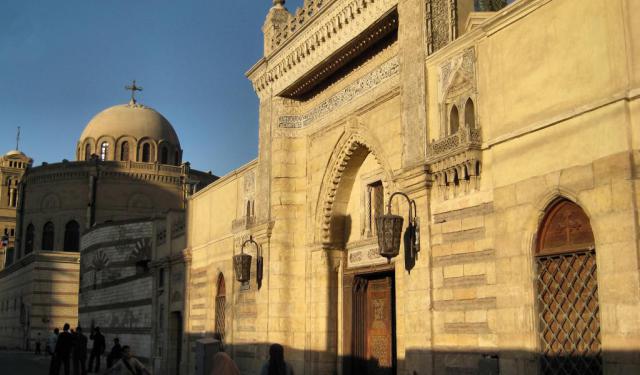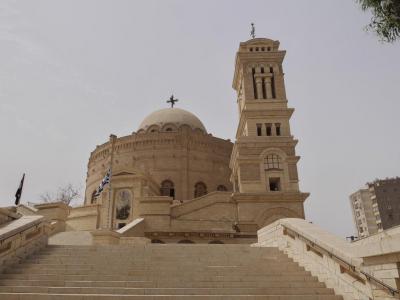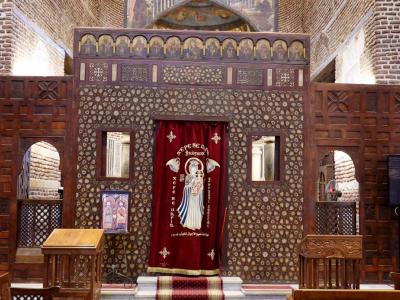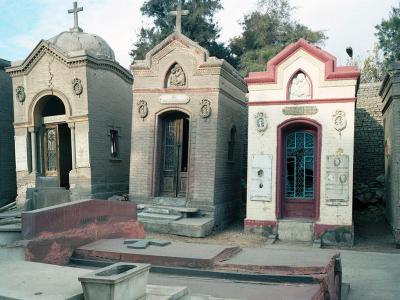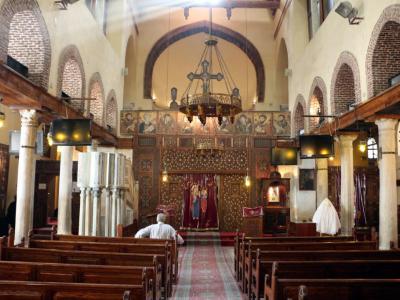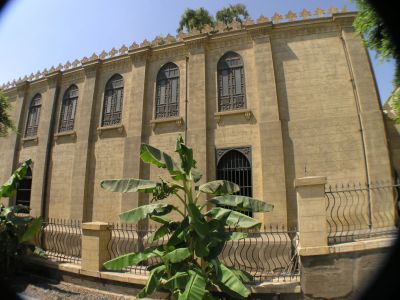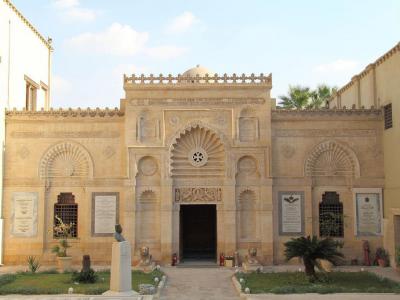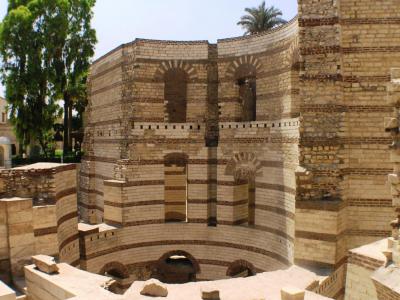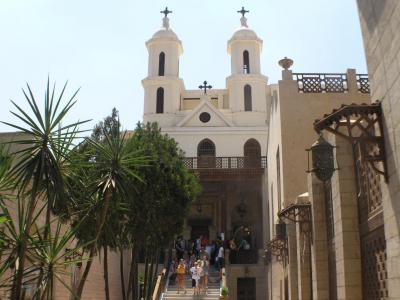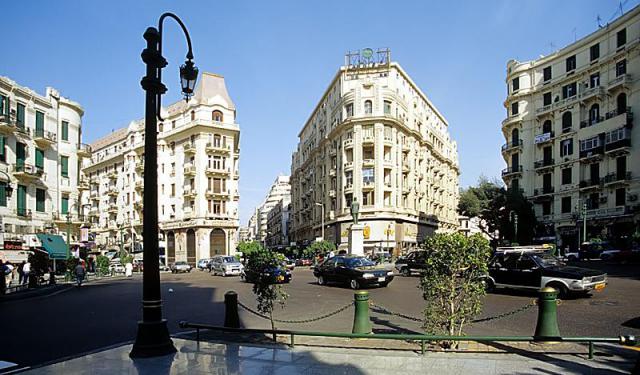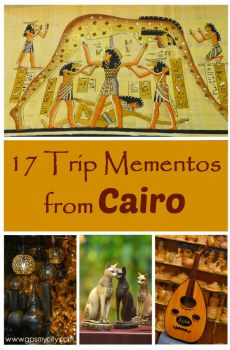Old Cairo Walking Tour (Self Guided), Cairo
Old Cairo, otherwise known as Coptic Cairo or Masr al-Qadima, largely predates the city of Cairo as we know it. Some Egyptologists think that a settlement here existed as far back as the 6th century BC. Later, the Romans built on the site a fortress named Babylon. Today, this ancient threshold of history is still in place, its weathered ramparts and sturdy bastions bearing witness to the ebb and flow of civilizations that have graced the fertile banks of the Nile.
At some point, Christians took over the territory, leaving behind as many as 20 churches in a space of just one square mile. The resplendent 7th-century Greek Orthodox Church of Saint George, rising majestically over the area, is one of the oldest and most prominent of them.
Another one, emerging as a celestial haven of reverence amid the labyrinthine alleyways of this historical enclave, is the Church of Saints Sergius and Bacchus. This sanctuary is said to have been built upon the spot where the Holy Family sought refuge during their flight to Egypt and, as such, is a popular pilgrimage site for Coptic Christians.
Deep within the maze of streets, not far from the Coptic Museum, the Ben Ezra Synagogue unveils its ancient mystique, evoking the essence of a storied past. The shrine is famous for its Genizah, a storage area where a vast collection of Jewish religious manuscripts were discovered in the late 19th century.
High above the bustling streets, The Hanging Church, also known as the Church of the Mother of God Saint Mary, delicately suspends itself between heaven and earth, supported by the ruins of two Roman towers. A masterpiece of architectural ingenuity and spiritual devotion, this temple is renowned for its beautiful Coptic artwork, intricately carved wooden screens, and historical significance.
In the heart of Old Cairo, whose stones remember the triumphs and tribulations of generations past, time continues to weave its intricate tapestry. Illuminating it like iridescent gems, the attractions of this venerable district beckon the intrepid explorer with a chance to be transported to a bygone era, where mighty conquerors and revered empires left indelible marks upon the sands of time. If you wish to delve into Egypt's religious and cultural heritage and experience the architectural splendor and historical significance of this unique area, take this self-guided walking tour of Old Cairo.
At some point, Christians took over the territory, leaving behind as many as 20 churches in a space of just one square mile. The resplendent 7th-century Greek Orthodox Church of Saint George, rising majestically over the area, is one of the oldest and most prominent of them.
Another one, emerging as a celestial haven of reverence amid the labyrinthine alleyways of this historical enclave, is the Church of Saints Sergius and Bacchus. This sanctuary is said to have been built upon the spot where the Holy Family sought refuge during their flight to Egypt and, as such, is a popular pilgrimage site for Coptic Christians.
Deep within the maze of streets, not far from the Coptic Museum, the Ben Ezra Synagogue unveils its ancient mystique, evoking the essence of a storied past. The shrine is famous for its Genizah, a storage area where a vast collection of Jewish religious manuscripts were discovered in the late 19th century.
High above the bustling streets, The Hanging Church, also known as the Church of the Mother of God Saint Mary, delicately suspends itself between heaven and earth, supported by the ruins of two Roman towers. A masterpiece of architectural ingenuity and spiritual devotion, this temple is renowned for its beautiful Coptic artwork, intricately carved wooden screens, and historical significance.
In the heart of Old Cairo, whose stones remember the triumphs and tribulations of generations past, time continues to weave its intricate tapestry. Illuminating it like iridescent gems, the attractions of this venerable district beckon the intrepid explorer with a chance to be transported to a bygone era, where mighty conquerors and revered empires left indelible marks upon the sands of time. If you wish to delve into Egypt's religious and cultural heritage and experience the architectural splendor and historical significance of this unique area, take this self-guided walking tour of Old Cairo.
How it works: Download the app "GPSmyCity: Walks in 1K+ Cities" from Apple App Store or Google Play Store to your mobile phone or tablet. The app turns your mobile device into a personal tour guide and its built-in GPS navigation functions guide you from one tour stop to next. The app works offline, so no data plan is needed when traveling abroad.
Old Cairo Walking Tour Map
Guide Name: Old Cairo Walking Tour
Guide Location: Egypt » Cairo (See other walking tours in Cairo)
Guide Type: Self-guided Walking Tour (Sightseeing)
# of Attractions: 8
Tour Duration: 1 Hour(s)
Travel Distance: 1.0 Km or 0.6 Miles
Author: felicity
Sight(s) Featured in This Guide:
Guide Location: Egypt » Cairo (See other walking tours in Cairo)
Guide Type: Self-guided Walking Tour (Sightseeing)
# of Attractions: 8
Tour Duration: 1 Hour(s)
Travel Distance: 1.0 Km or 0.6 Miles
Author: felicity
Sight(s) Featured in This Guide:
- The Greek Church of St. George
- The Church of Saints Sergius and Bacchus
- Old Coptic Cemetery of Cairo
- Saint Barbara Church
- Ben Ezra Synagogue
- Coptic Museum
- Babylon Fortress
- The Hanging Church
1) The Greek Church of St. George
The Greek Church of Saint George is a large round church located in the Babylon Fortress of Cairo. It is the seat of the Greek Patriarch of Alexandria.
The Greek Church of Saint George was built in 684 by a wealthy scribe called Athanasius. The present structure was built in 1904. It is connected to the nearby monastery of Saint George. It is believed that Saint George was imprisoned and martyred near the church. It was a Coptic church until the 15th century when it became a Greek orthodox church.
A flight of steps takes visitors to The Greek Church of Saint George. The façade has a relief of Saint George dressed as a Roman soldier astride an Arabian horse and slaying a dragon carved into the brick wall. The 20th century church still retains the stained glass windows of previous churches and the Qaa el-Arsan wedding chamber that dates back to the 4th century. It has beautifully carved interiors and the dome has a beautiful green ceiling with the image of Christ in the middle. Most of the images depict Saint George fighting for the preservation of Christianity. The nearby monastery is the venue of the largest Coptic Mulid or religious festival celebrated annually on the 23rd of April.
The Greek Church of Saint George was built in 684 by a wealthy scribe called Athanasius. The present structure was built in 1904. It is connected to the nearby monastery of Saint George. It is believed that Saint George was imprisoned and martyred near the church. It was a Coptic church until the 15th century when it became a Greek orthodox church.
A flight of steps takes visitors to The Greek Church of Saint George. The façade has a relief of Saint George dressed as a Roman soldier astride an Arabian horse and slaying a dragon carved into the brick wall. The 20th century church still retains the stained glass windows of previous churches and the Qaa el-Arsan wedding chamber that dates back to the 4th century. It has beautifully carved interiors and the dome has a beautiful green ceiling with the image of Christ in the middle. Most of the images depict Saint George fighting for the preservation of Christianity. The nearby monastery is the venue of the largest Coptic Mulid or religious festival celebrated annually on the 23rd of April.
2) The Church of Saints Sergius and Bacchus
The Church of Saints Sergius and Bacchus also called the Abu Serga is the oldest Coptic place of worship in Cairo. It is dedicated to two soldier saints from Syria. They were martyred during the reign of the Roman Emperor Maximilian.
The location of The Church of Saints Sergius and Bacchus is where the Holy family is said to have rested while fleeing from the oppressive rule of King Herod to Egypt. It is said that they lived here while Joseph worked in the nearby fortress. The church dates back to the fifth century and the present building dates back to the 8th century. On the first of June a special mass is held annually to commemorate the arrival of the Holy Family.
The Church of Saints Sergius and Bacchus or Abu Serga is in the shape of a basilica. There is a narthex, a nave and two aisles. The central sanctuary has a 13th century wooden screen with ebony panels inlaid with ivory. The frieze and icons in the church date back to the 15th and 16th centuries. It has a 10 meter deep crypt that is often flooded when the levels of the River Nile rise. The church has an active congregation and is the second most important Coptic Church in the city next to the Hanging Church.
The location of The Church of Saints Sergius and Bacchus is where the Holy family is said to have rested while fleeing from the oppressive rule of King Herod to Egypt. It is said that they lived here while Joseph worked in the nearby fortress. The church dates back to the fifth century and the present building dates back to the 8th century. On the first of June a special mass is held annually to commemorate the arrival of the Holy Family.
The Church of Saints Sergius and Bacchus or Abu Serga is in the shape of a basilica. There is a narthex, a nave and two aisles. The central sanctuary has a 13th century wooden screen with ebony panels inlaid with ivory. The frieze and icons in the church date back to the 15th and 16th centuries. It has a 10 meter deep crypt that is often flooded when the levels of the River Nile rise. The church has an active congregation and is the second most important Coptic Church in the city next to the Hanging Church.
3) Old Coptic Cemetery of Cairo
In the heart of Old Cairo's ancient quarters, lies one of the prettiest cemeteries in Egypt. Picturesque and serene, the Old Coptic Cemetery is a poignant testament to the eternal journey of the soul.
This burial ground is believed to have been in use since the early centuries of Christianity, around the early medieval period. As such, this is one of Egypt's oldest continuously used cemeteries, with some graves dating back more than a thousand years. Many a prominent Coptic figure has been laid to rest here.
Coptic Christians have unique burial practices, including specific rituals and ceremonies conducted by the church clergy. If you happen to be here when a funeral takes place, you may witness the ancient Egyptian custom of wailing at funerals. Oftentimes, women cry so loud that the entire compound learns of the departure of their loved one.
The cemetery is known for its collection of unique and intricately carved tombstones and mausoleums. Many graves display Coptic artwork and inscriptions, wonderfully ornate with statues of angels, saints, doves, crosses, and the like.
Echoing with whispered echoes of countless generations, this ancient necropolis carries the weight of centuries, embracing the serenity of eternity amid the delicate dance of fading light and somber shadows...
This burial ground is believed to have been in use since the early centuries of Christianity, around the early medieval period. As such, this is one of Egypt's oldest continuously used cemeteries, with some graves dating back more than a thousand years. Many a prominent Coptic figure has been laid to rest here.
Coptic Christians have unique burial practices, including specific rituals and ceremonies conducted by the church clergy. If you happen to be here when a funeral takes place, you may witness the ancient Egyptian custom of wailing at funerals. Oftentimes, women cry so loud that the entire compound learns of the departure of their loved one.
The cemetery is known for its collection of unique and intricately carved tombstones and mausoleums. Many graves display Coptic artwork and inscriptions, wonderfully ornate with statues of angels, saints, doves, crosses, and the like.
Echoing with whispered echoes of countless generations, this ancient necropolis carries the weight of centuries, embracing the serenity of eternity amid the delicate dance of fading light and somber shadows...
4) Saint Barbara Church
The Coptic Orthodox Church of Saint Barbara stands as one of the renowned parishes within the district of Coptic Cairo. Situated on the eastern side of the Babylon Fortress, it boasts a rich history dating back to either the 5th or 6th century AD. However, much like numerous other structures in Coptic architecture, it underwent multiple reconstructions, with a significant one occurring towards the close of the 11th century.
This church is celebrated for its valuable artifacts, which were relocated to the nearby Coptic Museum, a mere two-minute walk away. The architectural layout of Saint Barbara's Church, with its basilican structure and tripartite sanctuary, closely mirrors that of Abu Serga, also known as the Church of Saints Sergius and Bacchus. Adjacent to the church, there exists a convent comprising several edifices, including a school designed by the renowned architect Ramses Wissa Wassef.
Saint Barbara's Church, while a venerable example of ancient Coptic architecture, takes its design cues from ancient Basilicas. It encompasses an entrance, a narthex, a lengthy nave, multiple aisles, and three sanctuaries. As is customary in many Coptic Orthodox churches with multiple sanctuaries, the central sanctuary is of paramount importance and is dedicated to Saint Barbara.
This church is celebrated for its valuable artifacts, which were relocated to the nearby Coptic Museum, a mere two-minute walk away. The architectural layout of Saint Barbara's Church, with its basilican structure and tripartite sanctuary, closely mirrors that of Abu Serga, also known as the Church of Saints Sergius and Bacchus. Adjacent to the church, there exists a convent comprising several edifices, including a school designed by the renowned architect Ramses Wissa Wassef.
Saint Barbara's Church, while a venerable example of ancient Coptic architecture, takes its design cues from ancient Basilicas. It encompasses an entrance, a narthex, a lengthy nave, multiple aisles, and three sanctuaries. As is customary in many Coptic Orthodox churches with multiple sanctuaries, the central sanctuary is of paramount importance and is dedicated to Saint Barbara.
5) Ben Ezra Synagogue
The Ben Ezra Synagogue is the oldest Jewish place of worship in Cairo. The land was bought by Rabbi Ben Ezra of Jerusalem to build the synagogue and it was named after him.
Two legends exist about the location of the Ben Ezra Synagogue. Some believe that it was the place where baby Moses was found safe in the midst of bulrushes. The other legend says that it was here that the prophet Jeremiah regrouped the Jewish people after they were expelled from Jerusalem. In 1896, a collection of 100,000 documents relating to the history of the Jewish people in Egypt was found in the Geniza or store room. Most of the documents have been relocated in various museums in Europe and Britain.
The architecture of the Ben Ezra Synagogue has a basilica style. There are two floors, a lower floor for male worshippers and an upper floor for women. Steel bars divide the main hall into three parts. The central hall has the Bima or desk for Torah reading. Twelve columns support the roof and 6 marble steps lead to the wooden altar. The interiors are decorated in Turkish style floral and geometric patterns. Today, the synagogue has very few worshippers but has become a thriving tourist attraction in Cairo.
Two legends exist about the location of the Ben Ezra Synagogue. Some believe that it was the place where baby Moses was found safe in the midst of bulrushes. The other legend says that it was here that the prophet Jeremiah regrouped the Jewish people after they were expelled from Jerusalem. In 1896, a collection of 100,000 documents relating to the history of the Jewish people in Egypt was found in the Geniza or store room. Most of the documents have been relocated in various museums in Europe and Britain.
The architecture of the Ben Ezra Synagogue has a basilica style. There are two floors, a lower floor for male worshippers and an upper floor for women. Steel bars divide the main hall into three parts. The central hall has the Bima or desk for Torah reading. Twelve columns support the roof and 6 marble steps lead to the wooden altar. The interiors are decorated in Turkish style floral and geometric patterns. Today, the synagogue has very few worshippers but has become a thriving tourist attraction in Cairo.
6) Coptic Museum (must see)
The Cairo Coptic Museum is the repository of the largest collection of early Egyptian Christian art in the world. The displays tell the tale of Egypt between the age of the Pharaohs and Islamic rule.
The museum was established by Markus Simaika Pasha in 1910. It was built on land intended for a Coptic Church after the founder obtained permission from the Pope Cyril V of the Coptic Orthodox Church of Alexandria. The building and surrounding garden cover an area of 8000 square meters. It contains objects donated by the Coptic community and artifacts that were once housed in the Egyptian Museum. It became a State Museum in 1931.
Exhibits at the Coptic Museum are arranged on two floors. The third floor has a library with 1200 of the Nag Hammadi manuscripts, a valuable collection of early Christian Gnostic texts found near the town of Nag Hammadi in Upper Egypt. The library is only open to researchers and historians. The first floor has religious artifacts and objects made of carved stone, stucco work, religious frescoes, and wooden objects. The second floor has textiles, manuscripts, a valuable collection of Coptic icons and metal objects. It has a collection of over 16,000 works of art of which 12,000 are displayed at a given time.
Why You Should Visit:
Well organized and spacious; the dresses, manuscripts, sculptures, etc. induce a journey back into time by 1500-2000 years.
Tip:
The entry ticket is only to the museum; all other churches, the synagogue, structures around are free to visit and are indeed beautiful.
If you plan to take pictures inside, make sure you pay the extra fee at the entrance and keep the ticket you get.
The museum was established by Markus Simaika Pasha in 1910. It was built on land intended for a Coptic Church after the founder obtained permission from the Pope Cyril V of the Coptic Orthodox Church of Alexandria. The building and surrounding garden cover an area of 8000 square meters. It contains objects donated by the Coptic community and artifacts that were once housed in the Egyptian Museum. It became a State Museum in 1931.
Exhibits at the Coptic Museum are arranged on two floors. The third floor has a library with 1200 of the Nag Hammadi manuscripts, a valuable collection of early Christian Gnostic texts found near the town of Nag Hammadi in Upper Egypt. The library is only open to researchers and historians. The first floor has religious artifacts and objects made of carved stone, stucco work, religious frescoes, and wooden objects. The second floor has textiles, manuscripts, a valuable collection of Coptic icons and metal objects. It has a collection of over 16,000 works of art of which 12,000 are displayed at a given time.
Why You Should Visit:
Well organized and spacious; the dresses, manuscripts, sculptures, etc. induce a journey back into time by 1500-2000 years.
Tip:
The entry ticket is only to the museum; all other churches, the synagogue, structures around are free to visit and are indeed beautiful.
If you plan to take pictures inside, make sure you pay the extra fee at the entrance and keep the ticket you get.
7) Babylon Fortress
The Babylon Fortress is often called the birthplace of Cairo. It is the oldest part of the city and dates back to the Bronze Age.
The Babylon Fortress gets its name from Babylon in Mesopotamia. It is believed that the area was once ruled by the Mesopotamian King, Nebuchadnezzar. It was later the site where the Roman Emperor Trajan placed his legions to subjugate the people of Egypt. At the time it marked the boundary between Middle and Lower Egypt. Today it is part of Coptic Cairo where the Christian population of the city lives. When the Arabs invaded Egypt, the fortress defended the city for seven months before falling to the army led by General Amr Ibn Al As.
Today the Babylon Fortress has several Coptic structures built into its walls. The towers are 10 meters high and have a diameter of 31 meters. It has a pattern typical of Roman fortresses with five blocks of limestone and three blocks of brick. There are six Coptic churches, a convent and the Coptic Museum within the walls. It is also called the Qasr el Shamee or the Palace of Candles because candles illuminated the towers on the first of every month.
The Babylon Fortress gets its name from Babylon in Mesopotamia. It is believed that the area was once ruled by the Mesopotamian King, Nebuchadnezzar. It was later the site where the Roman Emperor Trajan placed his legions to subjugate the people of Egypt. At the time it marked the boundary between Middle and Lower Egypt. Today it is part of Coptic Cairo where the Christian population of the city lives. When the Arabs invaded Egypt, the fortress defended the city for seven months before falling to the army led by General Amr Ibn Al As.
Today the Babylon Fortress has several Coptic structures built into its walls. The towers are 10 meters high and have a diameter of 31 meters. It has a pattern typical of Roman fortresses with five blocks of limestone and three blocks of brick. There are six Coptic churches, a convent and the Coptic Museum within the walls. It is also called the Qasr el Shamee or the Palace of Candles because candles illuminated the towers on the first of every month.
8) The Hanging Church (must see)
The Hanging Church gets its name from being located above an old Roman Gatehouse in Cairo. Its nave hangs over a passage. The real name of the Church is Sitt Mariam or Saint Mary’s Church.
The Hanging Church is the best-known Coptic Church in Cairo. The Coptic church is one of the early Eastern Orthodox Churches which once had its seat in Alexandria. Today, the Hanging Church is the official residence of the Coptic Pope. It was built in the 7th century and it is believed that there were churches on the site from the 3rd or 4th centuries. It has been rebuilt several times in particular in the 10th century by the Patriarch Abraham.
The Hanging Church has a beautiful courtyard flanked by religious mosaics. The marble pulpit has thirteen pillars representing Jesus and the 12 apostles. It is famous for its icons and the oldest one is from the 8th century. The eastern end has three sanctuaries dedicated to the Virgin Mary, Saint George and Saint John the Baptist. The sanctuary screen dates back to the 12th or 13th centuries and is made of ebony inlaid with ivory. It has a row of seven large icons. The left screen has 17 icons and the right screen has 7 small icons on the top. The church is a thriving place of worship and important celebrations like the enthronement of patriarchs take place here.
Tip:
Go through the door in the wall on the right to enter a half-round part of the church built directly over one of the Roman gate's defensive towers, and from which a window allows you to look down sideways at the gate itself (which is fairly impressive). You can also catch another outside glimpse of the gate and the church on top of it if you walk past the street entrance to the south-west corner of the compound.
The Hanging Church is the best-known Coptic Church in Cairo. The Coptic church is one of the early Eastern Orthodox Churches which once had its seat in Alexandria. Today, the Hanging Church is the official residence of the Coptic Pope. It was built in the 7th century and it is believed that there were churches on the site from the 3rd or 4th centuries. It has been rebuilt several times in particular in the 10th century by the Patriarch Abraham.
The Hanging Church has a beautiful courtyard flanked by religious mosaics. The marble pulpit has thirteen pillars representing Jesus and the 12 apostles. It is famous for its icons and the oldest one is from the 8th century. The eastern end has three sanctuaries dedicated to the Virgin Mary, Saint George and Saint John the Baptist. The sanctuary screen dates back to the 12th or 13th centuries and is made of ebony inlaid with ivory. It has a row of seven large icons. The left screen has 17 icons and the right screen has 7 small icons on the top. The church is a thriving place of worship and important celebrations like the enthronement of patriarchs take place here.
Tip:
Go through the door in the wall on the right to enter a half-round part of the church built directly over one of the Roman gate's defensive towers, and from which a window allows you to look down sideways at the gate itself (which is fairly impressive). You can also catch another outside glimpse of the gate and the church on top of it if you walk past the street entrance to the south-west corner of the compound.
Walking Tours in Cairo, Egypt
Create Your Own Walk in Cairo
Creating your own self-guided walk in Cairo is easy and fun. Choose the city attractions that you want to see and a walk route map will be created just for you. You can even set your hotel as the start point of the walk.
Cairo Downtown Walking Tour
Egyptians often refer to Cairo as Maṣr, which is the Arabic name for Egypt. This is due to the city's importance for the country, in part manifested by its closeness to the ancient pyramids. Indeed, the area of present-day Cairo has been the center of Egypt since the days of the pharaohs. The strategic territory at the base of the Nile Delta first hosted the town of Memphis.
By the 4th... view more
Tour Duration: 2 Hour(s)
Travel Distance: 4.1 Km or 2.5 Miles
By the 4th... view more
Tour Duration: 2 Hour(s)
Travel Distance: 4.1 Km or 2.5 Miles
Useful Travel Guides for Planning Your Trip
17 Uniquely Egyptian Things to Buy in Cairo
A jewel, a rose... what else is there distinctly Cairo to bring home as a gift? Feeling lost for ideas? - Look in here to generate some and expand your souvenir-shopping...
The Most Popular Cities
/ view all
